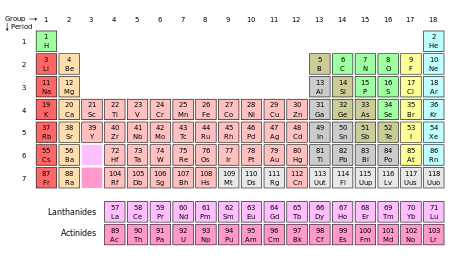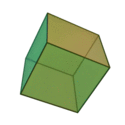
Chemical element
Background to the schools Wikipedia
SOS Children, an education charity, organised this selection. A good way to help other children is by sponsoring a child

A chemical element, or element, is a type of atom that is distinguished by its atomic number; that is, by the number of protons in its nucleus. The term is also used to refer to a pure chemical substance composed of atoms with the same number of protons.
Common examples of elements are hydrogen, carbon, nitrogen, and oxygen. In total, 117 Elements have been observed as of 2007, of which 94 occur naturally on Earth. Elements with atomic numbers greater than 82 (bismuth and above) are inherently unstable, and undergo radioactive decay. Of the first 82 elements, 80 have stable isotopes. Elements 43 and 61 (technetium and promethium) have no stable isotopes, and decay. The elements from 83 to atomic number 94 that have no stable nuclei, are nevertheless found in nature, either surviving as remnants of the primordial stellar nucleosynthesis which produced the elements in the solar system, or else as produced as newer short-lived daughter-isotopes in the natural decay of uranium and thorium.
All chemical matter consists of these elements. New elements of higher atomic number are discovered from time to time, as products of artificial nuclear reactions.
History
The term 'elements' (stoicheia) was first used by the Greek philosopher Plato in about 360 BCE, in his dialogue Timaeus, which includes a discussion of the composition of inorganic and organic bodies and is a rudimentary treatise on chemistry. Plato assumed that the minute particle of each element corresponded to one of the regular polyhedra: tetrahedron (fire), octahedron (air), icosahedron (water), and cube (earth).
 |
 |
 |
 |
|
| Tetrahedron (fire) | Octahedron (air) | Icosahedron (water) | Cube (earth) |
Adding to the four elements of the Greek philosopher Empedocles, in about 350 BC, Aristotle also used the term "element" and conceived of a fifth element called " quintessence", which formed the heavens. Aristotle defined an element as:
Element – one of those bodies into which other bodies can be decomposed and which itself is not capable of being divided into other.
Building on this theory, in c. 790 Arabian chemist Jabir ibn-Hayyan ( Geber) postulated that metals were formed out of two elements: sulphur, ‘the stone which burns’, which characterized the principle of combustibility, and mercury, which contained the idealized principle of metallic properties. Shortly thereafter, this evolved into the Arabic concept of the three principles: sulphur giving flammability or combustion, mercury giving volatility and stability, and salt giving solidity.
In 1524, Swiss chemist Paracelsus adopted Aristotle’s four element theory, but reasoned that they appeared in bodies as Geber’s three principles. Paracelsus saw these principles as fundamental, and justified them by recourse to the description of how wood burns in fire. Mercury included the cohesive principle, so that when it left in smoke the wood fell apart. Smoke represented the volatility (the mercury principle), the heat-giving flames represented flammability (sulphur), and the remnant ash represented solidity (salt).
In 1669, German physician and chemist Johann Becher published his Physica Subterranea. In modification on the ideas of Paracelsus, he argued that the constituents of bodies are air, water, and three types of earth: terra fluida, the mercurial element, which contributes fluidity and volatility; terra lapida, the solidifying element, which produces fusibility or the binding quality; and terra pinguis, the fatty element, which gives material substance its oily and combustible qualities. These three earths correspond with Geber’s three principles. A piece of wood, for example, according to Becher, is composed of ash and terra pinguis; when the wood is burnt, the terra pinguis is released, leaving the ash. In other words, in combustion the fatty earth burns away.
In 1661, Robert Boyle showed that there were more than just four classical elements as the ancients had assumed. The first modern list of chemical elements was given in Antoine Lavoisier's 1789 Elements of Chemistry, which contained thirty-three elements, including light and caloric. By 1818, Jöns Jakob Berzelius had determined atomic weights for forty-five of the forty-nine accepted elements. Dmitri Mendeleev had sixty-six elements in his periodic table of 1869, shown below.
From Boyle until the early 20th century, an element was defined as a pure substance that cannot be decomposed into any simpler substance. Put another way, a chemical element cannot be transformed into other chemical elements by chemical processes. In 1913, Henry Moseley discovered that the physical basis of the atomic number of the atom was its nuclear charge, which eventually led to the current definition. The current definition also avoids some ambiguities due to isotopes and allotropes.
By 1919, there were seventy-two known elements. In 1955, element 101 was discovered and named mendelevium in honour of Mendeleev, the first to arrange the elements in a periodic manner. In October 2006, the synthesis of element 118 was reported; however, element 117 has not yet been created in the laboratory.
Description
The lightest elements are hydrogen and helium, both created by Big Bang nucleosynthesis during the first 20 minutes of the universe in a ratio of around 3:1 by mass (approximately 12:1 by number of atoms). Almost all other elements found in nature, including some further hydrogen and helium created since then, were made by various natural or (at times) artificial methods of nucleosynthesis, including occasionally by activities such as nuclear fission.
As of 2006, there are 117 known elements (in this context, "known" means observed well enough, even from just a few decay products, to have been differentiated from any other element). Of these 117 elements, 94 occur naturally on Earth. Six of these occur in extreme trace quantities: technetium, atomic number 43; promethium, number 61; astatine, number 85; francium, number 87; neptunium, number 93; and plutonium, number 94. These 94 elements, and also possibly element 98 californium, have been detected in the universe at large, in the spectra of stars and also supernovae, where short-lived radioactive elements are newly being made.
The remaining 22 elements not found on Earth or in astronomical spectra have been derived artificially. All of the elements that are derived solely through artificial means are radioactive with very short half-lives; if any atoms of these elements were present at the formation of Earth, they are extremely likely to have already decayed, and if present in novae, have been in quantities too small to have been noted. Technetium was the first purportedly non-naturally occurring element to be synthesized, in 1937, although trace amounts of technetium have since been found in nature, and the element may have been discovered naturally in 1925. This pattern of artificial production and later natural discovery has been repeated with several other radioactive naturally occurring trace elements.
Lists of the elements by name, by symbol, by atomic number, by density, by melting point, and by boiling point as well as Ionization energies of the elements are available. The most convenient presentation of the elements is in the periodic table, which groups elements with similar chemical properties together.
Atomic number
The atomic number of an element, Z, is equal to the number of protons which defines the element. For example, all carbon atoms contain 6 protons in their nucleus; so the atomic number "Z" of carbon is 6. Carbon atoms may have different numbers of neutrons, which are known as isotopes of the element.
The number of protons in the atomic nucleus also determines its electric charge, which in turn determines the electrons of the atom in its non-ionized state. This in turn (by means of the Pauli exclusion principle) determines the atom's various chemical properties. So all carbon atoms, for example, ultimately have identical chemical properties because they all have the same number of protons in their nucleus, and therefore have the same atomic number. It is for this reason that atomic number rather than mass number (or atomic weight) is considered the identifying characteristic of an element.
Atomic mass
The mass number of an element, A, is the number of nucleons (protons and neutrons) in the atomic nucleus. Different isotopes of a given element are distinguished by their mass numbers, which are conventionally written as a super-index on the left hand side of the atomic symbol (e.g., 238U).
The relative atomic mass of an element is the average of the atomic masses of all the chemical element's isotopes as found in a particular environment, weighted by isotopic abundance, relative to the atomic mass unit (u). This number may be a fraction which is not close to a whole number, due to the averaging process. On the other hand, the atomic mass of a pure isotope is quite close to its mass number. Whereas the mass number is a natural (or whole) number, the atomic mass of a single isotope is a real number which is close to a natural number. In general, it differs slightly from the mass number as the mass of the protons and neutrons is not exactly 1 u, the electrons also contribute slightly to the atomic mass, and because of the nuclear binding energy. For example, the mass of 19F is 18.9984032 u. The only exception to the atomic mass of an isotope not being a natural number is 12C, which has a mass of exactly 12, due to the definition of u (it is fixed as 1/12th of the mass of a free carbon-12 atom, exactly).
Isotopes
Isotopes are atoms of the same element (that is, with the same number of protons in their atomic nucleus), but having different numbers of neutrons. Most (66 of 94) naturally occurring elements have more than one stable isotope. Thus, for example, there are three main isotopes of carbon. All carbon atoms have 6 protons in the nucleus, but they can have either 6, 7, or 8 neutrons. Since the mass numbers of these are 12, 13 and 14 respectively, the three isotopes of carbon are known as carbon-12, carbon-13, and carbon-14, often abbreviated to 12C, 13C, and 14C. Carbon in everyday life and in chemistry is a mixture of 12C, 13C, and 14C atoms.
All three of the isotopes of carbon have the same chemical properties. But they have different nuclear properties. In this example, carbon-12 and carbon-13 are stable atoms, but carbon-14 is unstable; it is slightly radioactive, decaying over time into other elements.
Like carbon, some isotopes of various elements are radioactive and decay into other elements upon radiating an alpha or beta particle. For certain elements, all their isotopes are radioactive isotopes: specifically the elements without any stable isotopes are technetium (atomic number 43), promethium (atomic number 61), and all observed elements with atomic numbers greater than 82.
Of the 80 elements with a stable isotope, 16 have only one stable isotope, and the mean number of stable isotopes for the 80 stable elements is 3.4 stable isotopes per element. The largest number of stable isotopes that occur for an element is 10 (for tin, element 50).
Allotropes
Some elements can be found as multiple elementary substances, known as allotropes, which differ in their structure and properties. For example, carbon can be found as diamond, which has a tetrahedral structure around each carbon atom; graphite, which has layers of carbon atoms with a hexagonal structure, and fullerenes, which have nearly spherical shapes. The ability for an element to exist in one of many structural forms is known as 'allotropy'.
Standard state
The standard state, or reference state, of an element is defined as its thermodynamically most stable state at 1 bar at a given temperature (typically at 298.15 K). In thermochemistry, an element is defined to have an enthalpy of formation of zero in its standard state. For example, the reference state for carbon is graphite, because it is more stable than the other allotropes.
Nomenclature
The naming of elements precedes the atomic theory of matter, although at the time it was not known which chemicals were elements and which compounds. When it was learned, existing names (e.g., gold, mercury, iron) were kept in most countries, and national differences emerged over the names of elements either for convenience, linguistic niceties, or nationalism. For example, the Germans use "Wasserstoff" for "hydrogen" and "Sauerstoff" for "oxygen", while English and some romance languages use "sodium" for "natrium" and "potassium" for "kalium", and the French, Greeks and Poles prefer "azote/azot" for "nitrogen".
But for international trade, the official names of the chemical elements both ancient and recent are decided by the International Union of Pure and Applied Chemistry, which has decided on a sort of international English language. That organization has recently prescribed that "aluminium" and "caesium" take the place of the US spellings "aluminium" and "cesium", while the US "sulfur" takes the place of the British "sulphur". But chemicals which are practicable to be sold in bulk within many countries, however, still have national names, and those which do not use the Latin alphabet cannot be expected to use the IUPAC name. According to IUPAC, the full name of an element is not capitalized, even if it is derived from a proper noun such as the elements californium or einsteinium (unless it would be capitalized by some other rule). Isotopes of chemical elements are also uncapitalized if written out: carbon-12 or uranium-235.
In the second half of the twentieth century physics laboratories became able to produce nuclei of chemical elements that have a half life too short for them to remain in any appreciable amounts. These are also named by IUPAC, which generally adopts the name chosen by the discoverer. This can lead to the controversial question of which research group actually discovered an element, a question which delayed the naming of elements with atomic number of 104 and higher for a considerable time. (See element naming controversy).
Precursors of such controversies involved the nationalistic namings of elements in the late nineteenth century. For example, lutetium was named in reference to Paris, France. The Germans were reluctant to relinquish naming rights to the French, often calling it cassiopeium. The British discoverer of niobium originally named it columbium, in reference to the New World. It was used extensively as such by American publications prior to international standardization.
Chemical symbols
Specific chemical elements
Before chemistry became a science, alchemists had designed arcane symbols for both metals and common compounds. These were however used as abbreviations in diagrams or procedures; there was no concept of atoms combining to form molecules. With his advances in the atomic theory of matter, John Dalton devised his own simpler symbols, based on circles, which were to be used to depict molecules.
The current system of chemical notation was invented by Berzelius. In this typographical system chemical symbols are not used as mere abbreviations - though each consists of letters of the Latin alphabet - they are symbols intended to be used by peoples of all languages and alphabets. The first of these symbols were intended to be fully universal; since Latin was the common language of science at that time, they were abbreviations based on the Latin names of metals - Fe comes from Ferrum, Ag from Argentum. The symbols were not followed by a period (full stop) as abbreviations were. Later chemical elements were also assigned unique chemical symbols, based on the name of the element, but not necessarily in English. For example, sodium has the chemical symbol 'Na' after the Latin natrium. The same applies to "W" (wolfram) for tungsten, "Hg" (hydrargyrum) for mercury, "K" (kalium) for potassium, "Au" (aurum) for gold, "Pb" (plumbum) for lead, and "Sb" (stibium) for antimony.
Chemical symbols are understood internationally when element names might need to be translated. There are sometimes differences; for example, the Germans have used "J" instead of "I" for iodine, so the character would not be confused with a roman numeral.
The first letter of a chemical symbol is always capitalized, as in the preceding examples, and the subsequent letters, if any, are always lower case (small letters).
General chemical symbols
There are also symbols for series of chemical elements, for comparative formulas. These are one capital letter in length, and the letters are reserved so they are not permitted to be given for the names of specific elements. For example, an "X" is used to indicate a variable group amongst a class of compounds (though usually a halogen), while "R" is used for a radical, meaning a compound structure such as a hydrocarbon chain. The letter "Q" is reserved for "heat" in a chemical reaction. "Y" is also often used as a general chemical symbol, although it is also the symbol of yttrium. "Z" is also frequently used as a general variable group. "L" is used to represent a general ligand in inorganic and organometallic chemistry. "M" is also often used in place of a general metal.
Isotope symbols
The three main isotopes of the element hydrogen are often written as H for protium, D for deuterium and T for tritium. This is in order to make it easier to use them in chemical equations, as it replaces the need to write out the mass number for each atom. It is written like this:
D2O ( heavy water)
Instead of writing it like this:
²H2O
Abundance
During the early phases of the Big Bang, nucleosynthesis of hydrogen nuclei resulted in the production of hydrogen and helium isotopes, as well as very minuscule amounts (on the order of 10-10) of lithium and beryllium. There is argument about whether or not some boron was produced in the Big Bang, as it has been observed in some very young stars, but no heavier elements than boron were produced. As a result, the primordial abundance of atoms consisted of roughly 75% 1H, 25% 4He, and 0.01% deuterium. Subsequent enrichment of galactic halos occurred due to Stellar nucleosynthesis and Supernova nucleosynthesis. However intergalactic space can still closely resemble the primordial abundance, unless it has been enriched by some means.
The following table shows the ten most common elements in our galaxy (estimated spectroscopically), as measured in parts per million, by mass. Nearby galaxies that have evolved along similar lines have a corresponding enrichment of elements heavier than hydrogen and helium. The more distant galaxies are being viewed as they appeared in the past, so their abundances of elements appear closer to the primordial mixture. As physical laws and processes appear common throughout the visible universe, however, it is expected that these galaxies will likewise have evolved similar abundances of elements.
| Element | Parts per million by mass |
|---|---|
| Hydrogen | 739,000 |
| Helium | 240,000 |
| Oxygen | 10,700 |
| Carbon | 4,600 |
| Neon | 1,340 |
| Iron | 1,090 |
| Nitrogen | 970 |
| Silicon | 650 |
| Magnesium | 580 |
| Sulfur | 440 |
Recently discovered elements
The first transuranium element (element with atomic number greater than 92) discovered was neptunium in 1940. The heaviest element that has been found to date is element 118, ununoctium, which was successfully synthesized on October 9, 2006, by the Flerov Laboratory of Nuclear Reactions in Dubna, Russia.
Element 117, ununseptium, has not yet been created or discovered, although its place in the periodic table is preestablished, and likewise for possible elements beyond 118.

